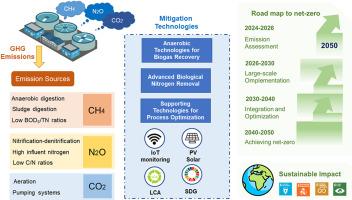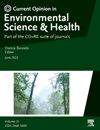Greenhouse gas emissions in industrial wastewater treatment: technologies, challenges, and strategies
IF 6.6
Q1 ENVIRONMENTAL SCIENCES
Current Opinion in Environmental Science and Health
Pub Date : 2025-08-21
DOI:10.1016/j.coesh.2025.100661
引用次数: 0
Abstract
Greenhouse gas (GHG) emissions from industrial wastewater treatment are increasingly acknowledged as a significant contributor to climate change but remain underrepresented in mitigation strategies, especially in developing countries. Methane (CH4), nitrous oxide (N2O), and carbon dioxide (CO2) are emitted through anaerobic digestion, biological nitrogen removal, and energy-intensive operations. In Vietnam, centralized WWTPs have reported emissions as high as 476.1 MtCO2e from CH4 and 13,103.9 MtCO2e from N2O, emphasizing the need for targeted intervention. It is hypothesized that when equipped with low-emission technologies and supported by integrated approaches, such as energy recovery, optimized nutrient removal, and real-time digital monitoring, industrial wastewater systems can be transformed into climate-resilient infrastructure with significantly reduced emission intensities. In this review, mitigation pathways are synthesized through a critical evaluation of peer-reviewed literature, field-based data, and global policy frameworks. Key emission factors, including 0.0011 g CH4/g BOD5 and 0.0017 g N2O–N/g TN-influent, are analyzed alongside operational metrics. Technologies such as anaerobic membrane bioreactors (AnMBRs), partial nitritation–anammox (PN/A) processes, AME-AD systems, and photovoltaic-supported biogas recovery are comprehensively reviewed. A four-phase roadmap to net-zero emissions by 2050 is proposed, integrating life cycle assessment, AI-enhanced monitoring, and carbon finance mechanisms. Emphasis is placed on the co-benefits of GHG mitigation strategies for public health resilience, energy security, and the achievement of Sustainable Development Goals. By repositioning industrial wastewater as a strategic entry point for climate action, this study outlines actionable, cross-sectoral solutions to support decarbonization and circular economy transformation in rapidly industrializing economies. These findings hold particular relevance for journals focusing on environmental engineering, sustainable infrastructure, climate governance, and low-carbon development pathways.

工业废水处理中的温室气体排放:技术、挑战和策略
工业废水处理产生的温室气体(GHG)排放日益被认为是造成气候变化的一个重要因素,但在缓解战略中所占比例仍然不足,尤其是在发展中国家。甲烷(CH4)、氧化亚氮(N2O)和二氧化碳(CO2)通过厌氧消化、生物脱氮和能源密集型操作排放。在越南,集中式污水处理厂报告的CH4排放量高达4.761亿吨二氧化碳当量,N2O排放量高达13103.9亿吨二氧化碳当量,这强调了有针对性干预的必要性。我们假设,当配备低排放技术并辅以能源回收、优化营养物去除和实时数字监测等综合方法时,工业废水系统可以转变为具有气候适应型的基础设施,显著降低排放强度。在本综述中,通过对同行评议文献、实地数据和全球政策框架的批判性评估,综合了缓解途径。关键排放因子,包括0.0011 g CH4/g BOD5和0.0017 g N2O-N /g tn,与操作指标一起分析。对厌氧膜生物反应器(anmbr)、部分硝化-厌氧氨氧化(PN/A)工艺、AME-AD系统和光伏支持的沼气回收等技术进行了全面综述。提出了到2050年实现净零排放的四阶段路线图,整合了生命周期评估、人工智能增强监测和碳融资机制。重点是温室气体缓解战略对公共卫生抗灾能力、能源安全和实现可持续发展目标的共同益处。通过将工业废水重新定位为气候行动的战略切入点,本研究概述了可操作的跨部门解决方案,以支持快速工业化经济体的脱碳和循环经济转型。这些发现对关注环境工程、可持续基础设施、气候治理和低碳发展途径的期刊尤其重要。
本文章由计算机程序翻译,如有差异,请以英文原文为准。
求助全文
约1分钟内获得全文
求助全文
来源期刊

Current Opinion in Environmental Science and Health
Medicine-Public Health, Environmental and Occupational Health
CiteScore
14.90
自引率
0.00%
发文量
92
审稿时长
114 days
 求助内容:
求助内容: 应助结果提醒方式:
应助结果提醒方式:


